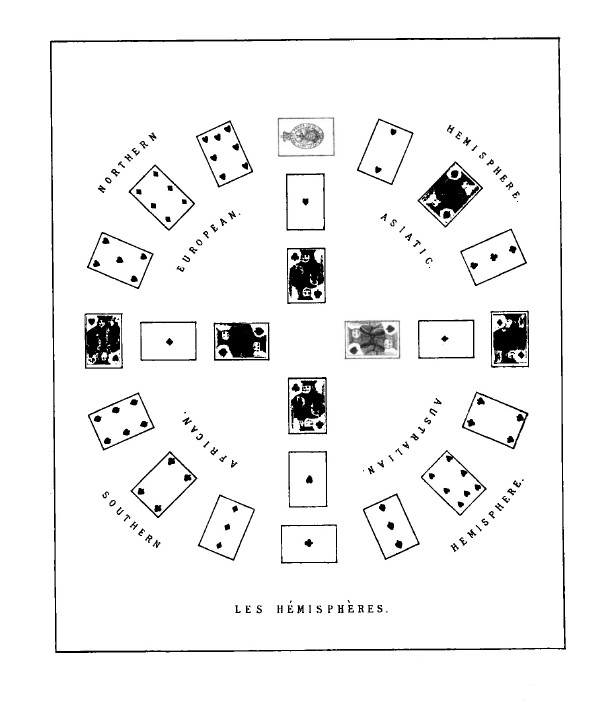
LES
HÉMISPHÈRES.
TWO
ENTIRE PACKS OF CARDS.
RULES.
I.
ONLY cards that belong to their proper hemisphere are available.
II.
Cards of the wrong colours may be exchanged into their proper
hemispheres whenever the opportunity occurs, and at the end of the
game, when all the cards are dealt, and the talon is exhausted, they
may be transferred without an exchange.
III.
Cards may only marry those belonging to their own Race, but cards
from the talon may marry those of any Race.
IV.
The barriers cannot be moved till the end of the game, when they are
played to complete the foundations.
V.
All the foundations must follow suit.
PLAY.
Take
from the pack and place as in tableau the four red aces and the four
black kings.
Then
place crossways a king of hearts and a king of diamonds, an ace of
clubs and an ace of spades. The four latter cards are called
barriers, and divide each Race.
The
four black kings and the four red aces form the foundation cards, the
aces ascending in sequence to kings, the kings descending in sequence
to aces.
The
red cards representing Europeans and Asiatics should inhabit the
northern hemisphere, the black cards representing Australians and
Africans the southern; but it is obvious that in dealing and
re-filling vacancies, cards will often be found in the wrong
hemispheres, and while there they cannot 6e used in any way.
Having
placed the foundations and the barriers, deal out (from left to
right, beginning from the king of hearts) a circle consisting of
three cards between each barrier. These represent the four Races.
From these Races you play, marry and exchange all available cards,
subject to Rules I. II. III. and V.
Note.
— The red suits marry in descending, the black in ascending line.
This
done, you deal out the remainder of the pack, first re-filling
vacancies in the Races (proceeding from left to right, as in the
original deal) and then playing all suitable cards. The rest form the
talon, from which cards may marry those in the circle, subject to
Rules I. and III.
There
is no re-deal.
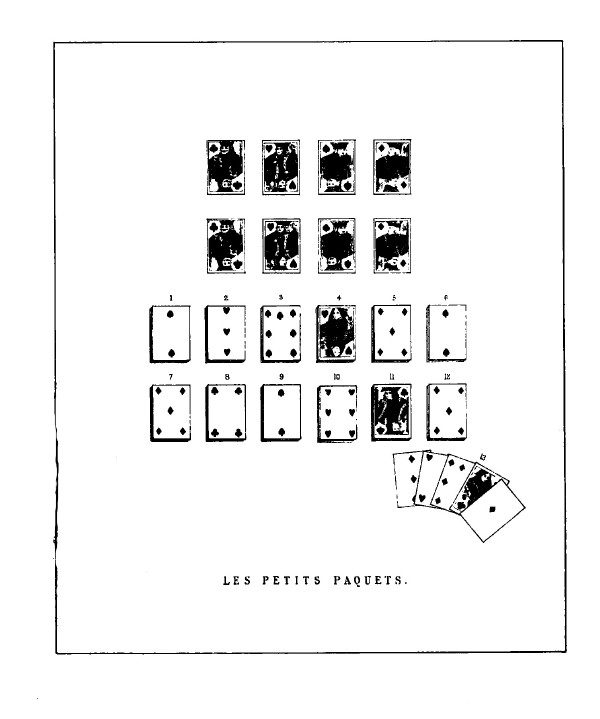
LES
PETITS PAQUETS.
TWO
ENTIRE PACKS OF CARDS.
RULES.
I.
ANY card in the thirteenth packet, and the surface or uppermost cards
of the twelve packets, are available. By the removal of the top cards
those beneath are released in the usual manner.
II.
Each foundation must follow suit.
III.
In re-dealing, the twelve packets are to be taken up in order, six in
one hand and six in the other (taking the right hand upper and the
left hand lower rows alternately). Between the two groups place the
thirteenth packet if any cards of it remain.
PLAY.
Withdraw
from the pack and play the eight kings as in tableau. These are the
foundation cards. The four kings in the upper row begin with aces,
and ascend in sequence to queens; the kings in the lower row descend
in sequence to aces.
Before
proceeding, read the following directions to the end.
Deal
out thirteen cards in two horizontal rows, the thirteenth card being
placed a little apart. Then deal out a second round of thirteen cards
to cover the first, and continue thus to deal out successive rounds
until the pack is exhausted, the cards in the thirteenth packet being
so spread that the whole are visible, while the other twelve packets
only show the surface card of each.
But
in dealing each several round the following order of play is to be
observed.
Each
card is to be called by the numerical order in which it is dealt,
irrespective of its actual value (the knave counting eleven, the
queen twelve and the king thirteen). Whenever the actual value of any
card corresponds to its number in the deal, that card is to be laid
aside, face downwards, and is called the Exile (see tableau). When a
card is thus laid aside, the next one in the pack must be placed in
its stead, and the deal continued as before, invariably banishing as
Exiles all those cards whose value and conventional number agree;
each round begins with number one and ends with thirteen.
The
whole of the cards having been thus dealt out, examine all the
thirteen packets (Rule I.), and play any available cards on the
foundations.
When
no more can thus be played, take the uppermost card of the Exiles and
(if not suitable for any of the foundations) place it underneath the
packet to whose conventional number its own value corresponds; i. e.
if the card is a five, slip it underneath the fifth packet, if a
queen, under the twelfth, and so on. Then the top card of the same
packet is to be treated in like manner (placed underneath the packet
corresponding to its value), until by these changes of the
surface cards a suitable one for any of the foundations is released.
Having
played the card so released, and having again carefully examined the
packets as before, playing all that are suitable, the next card of
the Exiles must be taken, and the same process repeated until all the
Exiles have been used.
The
packets are then to be taken up in order (Rule III.), re-dealt (if
necessary) twice, and played exactly as before.
In
forming the foundations one card at a time may be exchanged from the
ascending to the descending sequences, and vice versa.
Note.
— In the pattern tableau several rounds are represented to have
been dealt, but in playing a game some of the foundations would by
that time have been begun.
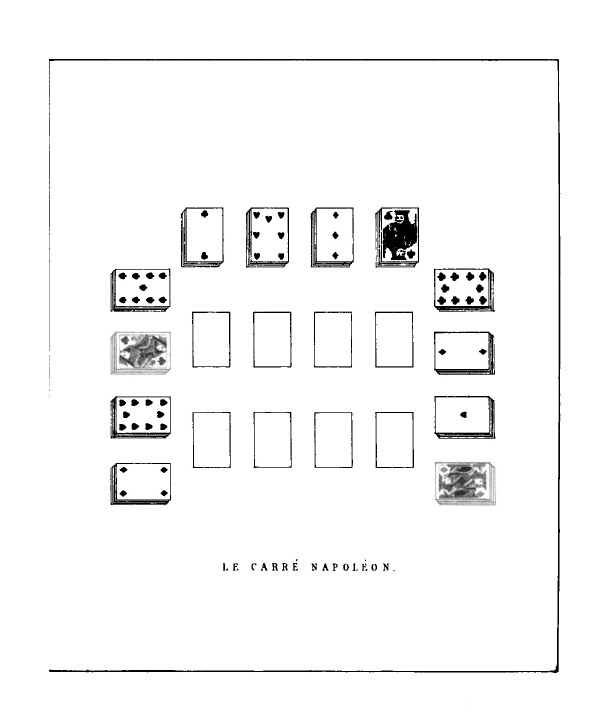
LE
CARRÉ NAPOLÉON.
TWO
ENTIRE PACKS OF CARDS.
RULES.
I.
ONLY the uppermost cards of the packets in the square are available,
until, by their removal, the cards underneath are released, but the
whole of the square may be examined.
II.
When a vacancy in the square is caused by the removal of an entire
packet, the space may be filled by one card from the talon or pack,
but this need not be done until a favourable opportunity occurs.
III.
All the foundations must follow suit.
PLAY.
Deal
out twelve packets, each consisting of four cards dealt together, so
as to form three sides of a square, leaving space in the centre for
the eight aces. These are the foundation cards, and are to ascend in
sequence to kings.
If
any aces appear on the surface of the square, play them in their
allotted places, as also any other suitable cards.
You
next proceed to form marriages in a descending line with the cards of
the square, subject to Rule I. As usual, great judgment must
he
exercised in making these changes, lest cards underneath should be
blocked by a sequence of higher cards of the same suit. If this were
to occur in two packets, i. e. if in both cases sequences, say of
diamonds, blocked lower cards of the same suit, success would be
impossible.
Notes
— If after dealing the square two kings of one suit were found to
be blocking two smaller cards of that suit, either the whole must be
taken up and re-dealt, or one king must be slipped underneath.
You
now proceed to play out the rest of the cards, those that are not
suitable for the foundations or for the sequences of the square being
placed in a talon.
There
is no re-deal.
This
game may be also played as follows — Deal out a square of twelve
single cards, then deal the rest of the pack as usual, the cards that
are suitable being played on the foundations or married (in
descending line) to those on the square, ready to be transferred to
the foundations, the rest placed in a talon, and vacancies filled in
the usual manner.
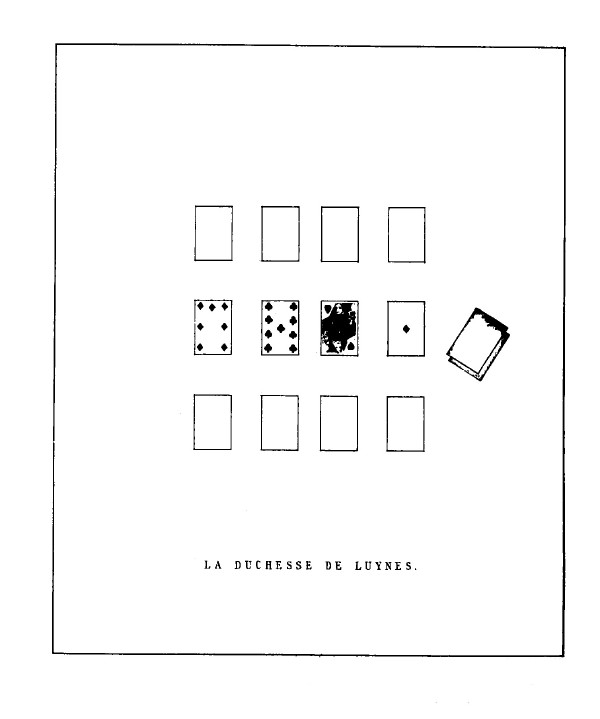
LA
DUCHESSE DE LUYNES.
TWO
ENTIRE PACKS OF CARDS.
RULES.
I.
THE uppermost cards of each of the packets are available, as are also
those below, when the cards covering them are removed. The Discard is
only available at the end of each deal.
II.
The foundations must follow suit.
PLAY.
Deal
out in a horizontal row four cards face upwards, then place two cards
apart face downwards. These latter are the Discard. Four aces and
four kings of different suits form the foundations, the aces
ascending in sequence to kings, the kings descending in sequence to
aces.
When
any of these foundation cards appear in the course of the deal, play
them in their allotted spaces (the aces above, the kings below), as
also any other suitable cards, subject to Rule I.
Having
dealt this first round, proceed to deal successive rounds, each
covering the preceding one, and adding two cards each time to the
Discard. Between every round pause, and play all suitable cards on
the foundations. The spaces so made are never to be re-filled until
the succeeding round of cards is placed which naturally covers them.
When
the entire pack is exhausted take up the Discard, examine it, and
play from it all suitable cards on the foundations, of course adding,
as before, any from the surface of the four packets.
When
further progress is at an end, take up the four packets in
succession, placing the Discard underneath, and re-deal the whole as
before, playing it exactly in the same manner.
There
may be three re-deals, but in the last or fourth deal no Discard is
placed.
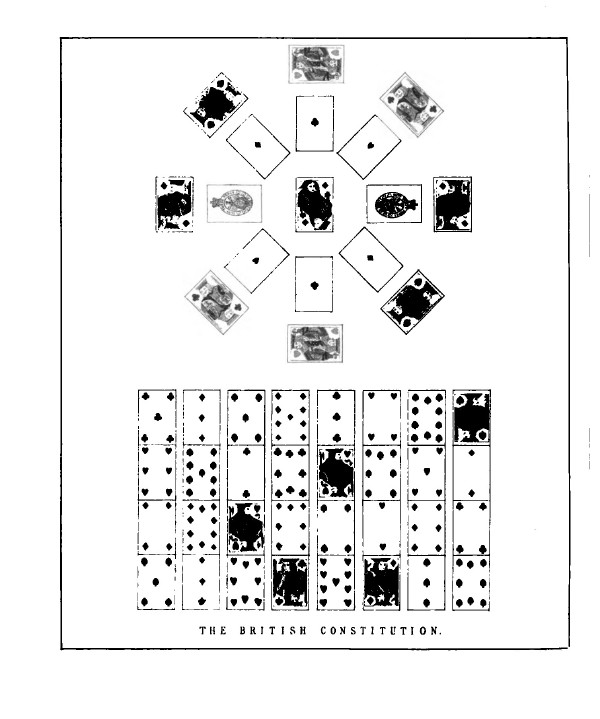
THE
BRITISH CONSTITUTION.
TWO
ENTIRE PACKS OF CARDS.
RULES.
I.
THE foundations are formed exclusively from the "Privy Council."
All cards in the other divisions, pack, or talon, must ascend through
each division till they reach the top before they can be played.
II.
Cards in the three lower divisions may be placed in sequence on cards
in the next division above them, and in this manner they may be
transferred from one division to another till they reach the top.
III.
When cards are placed in sequence in the "Constitution,"
the top card only of each sequence is available until its removal
releases the one beneath.
IV.
All sequences must be of alternate colours, and in descending line —
i. e.
a red nine on a black ten, then a black eight, a red seven, and so
on. Any number of cards may be so placed.
V.
Each vacancy must be at once filled by a card from the division
immediately below it; and as this rule applies equally to all the
rows, a vacancy will thus be caused in the lowest row or "People,"
which must be filled from the talon, or, when there is no talon, from
the pack.
VI.
The foundations must follow suit.
PLAY.
Take
from the pack the kings, queens, and aces — seven of the queens are
to be thrown aside, and the other cards placed as in tableau.
The
queen of clubs represents THE SOVEREIGN, the black kings the Bishops,
the red kings the Judges.
The
eight aces form the foundation cards or "Government," and
ascend in sequence to knaves.
Deal
out four horizontal rows (beginning with the lowest), each containing
eight cards.
This
forms the "Constitution." Each row represents a separate
division.
The
first (or lowest row) is the "People," the second the
"House of Commons," the third the "House of Lords,"
the last the "Privy Council."
When
the tableau is complete, if any suitable cards are to be found in the
"Privy Council" row, play them (Rule I.), immediately
re-filling each vacancy as it is made (Rule V.).
You
must then examine the Constitution to see which cards may be most
advantageously placed in sequence (Rules II. and IV.).
Note.
— The success of this game depends chiefly on the play. In filling
a vacancy choose the card (Rule V.) which has the most chance of
reaching the top, or of being useful to cards in the row below it. It
is often better to defer making a vacancy till a card turns up in
dealing that is required.
When
you have played all available cards and placed in sequence all that
you wish, deal out the remainder of the pack, the cards not required
to fill vacancies in the "People" forming the talon.
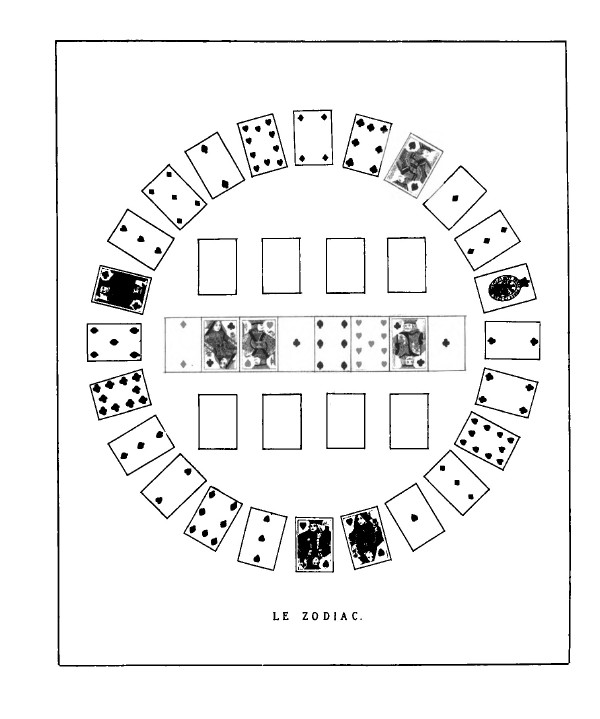
THE
ZODIAC.
TWO
ENTIRE PACKS OF CARDS.
RULES.
I.
MARRIAGES may be made in the Zodiac with cards from the Equator (but
not vice versa) and from the talon or pack, but cards in the Zodiac
cannot marry each other, neither can those in the Equator do so.
Marriages may be made in ascending and descending lines, and the same
packet may contain both.
II.
The foundations must follow suit.
PLAY.
Deal
eight cards in a horizontal row called the "Equator." Then
deal a surrounding circle of twenty-four cards called the "Zodiac."
The
foundations are not formed till the end of the game. They are to
consist of the four aces and four kings of different suits, the aces
ascending in sequence to kings, the kings descending in sequence to
aces.
Having
placed the tableau, you proceed to marry (Rule I.) and to re-fill the
spaces from the talon, or, where there is no talon, from the pack,
but you are not obliged to do either until a favourable opportunity
occurs. You continue to deal out the cards in the usual way, those
not required for marrying or for re-filling spaces forming the talon.
This is to be re-dealt as often as required — that is, until all
the cards are placed either in the Zodiac or in the Equator. If this
cannot be done the patience has already failed. If you succeed in
placing all the cards you then begin to form the eight foundations
from the Zodiac and Equator (Rule II.).
It
is obvious that the greatest care is required in marrying the cards,
or you will so block them as to be unable to form the foundations.
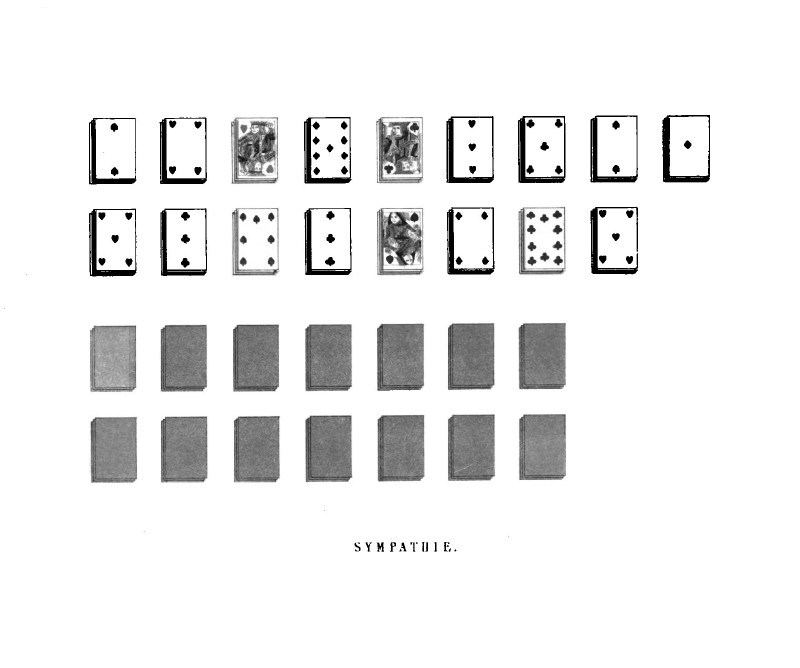
SYMPATHIE.
FOR
TWO PLAYERS.
TWO
ENTIRE PACKS OF CARDS.
PLAY.
EACH
player takes one of the packs, and deals it in packets of three cards
together, face downwards; each player will thus have seventeen
packets, and one card over as a "grace."
The
first player now turns the uppermost card of each of his packets, or
if preferred, he may in dealing turn these cards. See tableau.
When
this has been done, the second player proceeds to turn the uppermost
cards of each of his packets, one by one, and whenever a card so
turned corresponds in value and suit with any upturned card of the
first player, both the cards thus paired are withdrawn and laid aside
by their respective owners, and the next card of the packet from
which the successful one was taken, is paired if possible in the same
manner. This process is repeated till the uppermost card of each of
the packets is face upwards.
The
first player having now some packets face downwards, proceeds to turn
the uppermost cards in the same manner, and to pair them when
possible. Each player continues this process alternately until
further progress is at an end. Then each has recourse by turns to his
"grace," after which, if any cards remain on the table
unturned, the game has failed, and "Sympathie" between the
players has not been established.
|